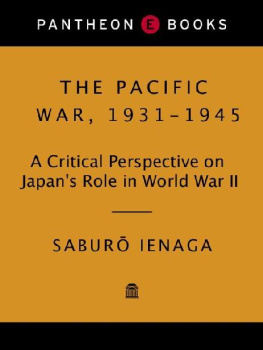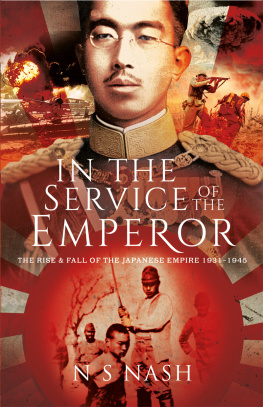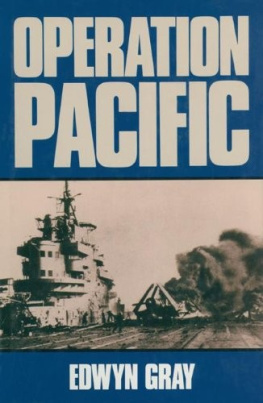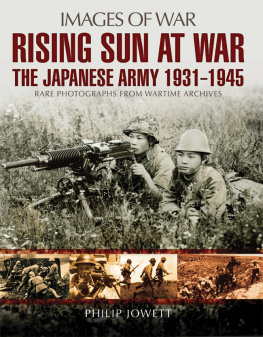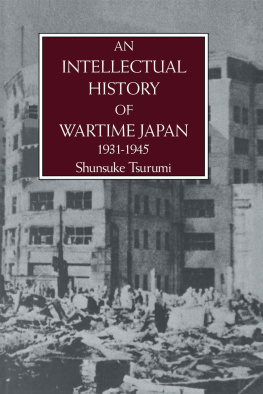Saburō Ienaga - The Pacific War, 1931–1945: A Critical Perpective on Japan’s Role in World War II
Here you can read online Saburō Ienaga - The Pacific War, 1931–1945: A Critical Perpective on Japan’s Role in World War II full text of the book (entire story) in english for free. Download pdf and epub, get meaning, cover and reviews about this ebook. year: 0, publisher: Pantheon, genre: History. Description of the work, (preface) as well as reviews are available. Best literature library LitArk.com created for fans of good reading and offers a wide selection of genres:
Romance novel
Science fiction
Adventure
Detective
Science
History
Home and family
Prose
Art
Politics
Computer
Non-fiction
Religion
Business
Children
Humor
Choose a favorite category and find really read worthwhile books. Enjoy immersion in the world of imagination, feel the emotions of the characters or learn something new for yourself, make an fascinating discovery.
- Book:The Pacific War, 1931–1945: A Critical Perpective on Japan’s Role in World War II
- Author:
- Publisher:Pantheon
- Genre:
- Year:0
- Rating:4 / 5
- Favourites:Add to favourites
- Your mark:
- 80
- 1
- 2
- 3
- 4
- 5
The Pacific War, 1931–1945: A Critical Perpective on Japan’s Role in World War II: summary, description and annotation
We offer to read an annotation, description, summary or preface (depends on what the author of the book "The Pacific War, 1931–1945: A Critical Perpective on Japan’s Role in World War II" wrote himself). If you haven't found the necessary information about the book — write in the comments, we will try to find it.
Saburō Ienaga: author's other books
Who wrote The Pacific War, 1931–1945: A Critical Perpective on Japan’s Role in World War II? Find out the surname, the name of the author of the book and a list of all author's works by series.
The Pacific War, 1931–1945: A Critical Perpective on Japan’s Role in World War II — read online for free the complete book (whole text) full work
Below is the text of the book, divided by pages. System saving the place of the last page read, allows you to conveniently read the book "The Pacific War, 1931–1945: A Critical Perpective on Japan’s Role in World War II" online for free, without having to search again every time where you left off. Put a bookmark, and you can go to the page where you finished reading at any time.
Font size:
Interval:
Bookmark:

English translation Copyright 1978 by Random House, Inc.
All rights reserved under International and Pan-American Copyright Conventions. Published in the United States by Pantheon Books, a division of Random House, Inc., New York, and simultaneously in Canada by Random House of Canada Limited, Toronto.
TAIHEIY SENS (The Pacific War)
by Sabur Ienaga
Copyright 1968 by Sabur Ienaga
Originally published in Japanese by IWANAMI SHOTEN,
Publishers, Tokyo, 1968.
Library of Congress Cataloging in Publication Data
Ienaga, Sabur, 1913
The Pacific War.
(The Pantheon Asia Library)
Translation of Taiheiy sens.
1. World War, 19391945Japan. 2. JapanHistory19121945. I. Title.
D767.2.I313 1978 940.5352 77-88768
eISBN: 978-0-307-75609-1
v3.1
Japans surrender to the Allies on August 15, 1945, ended a disastrous fifteen-year military adventure into China, Southeast Asia, and the Pacific Islands. Contemporary Japan offers a before-after contrast rare in the annals of imperialist expansion. The nation ruled by myths of imperial divinity and sacred mission and dominated by generals and thought police who indoctrinated a supine public into obedience and militarism is a dim memory. In its place a society informed by more rational and thoroughly secular values has developed. The countrys modest military forces are defensive, restricted by legal and fiscal restraints, and threaten no other nation. Japan today has few if any pretensions to Big Power hubris.
Sabur Ienagas career spans the periods of Japan on the warpath and Japan on the mend. He has made explicit and activist commitments to building and preserving the postwar society of civil liberties, disarmament, and peace. In the turbulent decade after Japan regained its sovereignty in 1952, the new political order was threatened by conservative and rightist forces determined to turn the clock back. Attempts to revise the 1947 Constitution, increase police powers, and revive patriotic values were the hallmarks of authoritarian revanchism. But so far the political forces set free after 1945liberal and leftist political parties, unions, far-sighted business leaders and intellectualshave held the line.
Ienagas concern that Japan might again suffer the stifling pall of censorship and indoctrination has guided his scholarly interests and political activities. In the latter realm, his long battle against the Ministry of Educations authority to certify textbooks is one of the most celebrated legal battles of the postwar era. As much a campaign of public education as a bid to prevent what Ienaga considers an undesirable revival of central authority over education, the case is at present before the Supreme Court.
That Japan should not again be a bad neighbor to Korea, China, and Southeast Asia has been fundamental to Ienagas vision of a peaceful international community. Ienaga has dissented, for example, from his governments policy of a military alliance with the United States and support for American containment of China and intervention in Indochina. Many Japanese, Ienaga included, see unhappy similarities between Japans expansionism and Americas record in Asia since the late 1940s.
How can a historian help to prevent collective amnesia? As the Pacific War fades into the past, young Japanese know less of its horrors and of the conformist society that spawned aggression. Many of Ienagas generation and persuasion fear that ignorance of the 1930s and the war presages militarism and an indifference to civil liberties. The next phase may be to isolate and silence criticism in favor of a neoconservative national consensus, followed by expanded military forces and a slide toward the authoritarian past.
Ienaga wrote The Pacific War to remind a new generation that its peace and prosperity have roots in the fascism and aggression of the 1930s. It was not Ienagas purpose to revive war guilt over atrocities or to castigate villains by reciting the record of stupidity in high places. He sought to rekindle idealism and dedication to a free and peaceful society, to keep Japan on an even domestic and international keel. That, in his judgment, could best be done by describing the horrors of war. Otherwise, a generation raised on sugar-coated history would be likely to repeat the errors of the past.
The Pacific War blends analysis of institutionsthe Meiji Constitution, the educational system, and the militarywith a narrative account of the rapid, bizarre escalation of military operations. The authors methodology is deceptively simple. Ienaga asks, How could the Japanese people have prevented the war? The question directs attention away from conventional diplomatic historyalthough without prejudice to this approachtoward those political and intellectual fetters on a populace that prevent it from influencing national policy. It presumes that an enlightened public may prevent an irrational war regardless of the economic or strategic pressures impelling the elite toward conflict.
Applied to the U.S. intervention in Indochina, for example, Ienagas approach would focus relatively less on the record of senior policymakers as revealed in the Pentagon Papers and more on the American educational system and the media. The crucial question might be, How could the American people have been made to believe that intervention in a nationalist revolution in a corner of Southeast Asia was any of their business, let alone a major strategic interest worthy of the nations blood and treasure?
Another aspect of Ienagas methodology is the use of accounts by Japanese individuals who saw the face of war and were directly affected by the conflict. The author draws widely upon materials by ordinary soldiers, refugees, housewives, schoolchildren, and even enemy prisoners of war. The use of these sources demystifies war. It is no longer a grand test of national honor, a time of reckless heroism and devotion to duty. War is separation, privation, rape, deaththe body of a Chinese woman by a road in northern China or a wounded Japanese soldier abandoned along a jungle road in Burma. The Pacific War described by participants bears little resemblance to the version often presented on Japanese television and in the movies. Ienagas sources are an antidote to this entertaining but insidious pap.
While The Pacific War was written for Japanese readers, the book affords an insight into the persistence of pacifism, the antagonism to rearmament, and the reluctance of most Japanese to accept the conventional wisdom that an economic power must inevitably also become a military power. Perhaps that is the cardinal enduring lesson from the war.
Frank Baldwin
the English Edition
I wrote this book to show the Japanese people the naked realities of the Pacific War. My objective was to stimulate reflection and self-criticism about the war.
With the development of weapons of indiscriminate mass murder and the real possibility of a nuclear holocaust, Japans experience of the horrors of war may prove a valuable lesson for other countries as well. Our postwar Constitution renounces war and stipulates that war potential is never to be maintained. The Japanese peoples efforts to achieve these goals stem from a fervent hope that our country will never again experience such a tragedy. The ideal of eternal peace for all mankind has also shaped our attitudes toward war and armaments.
The publication of The Pacific War in an English edition now makes the book available to a larger audience. To me the appearance of an English edition is both highly significant and extremely gratifying.
Font size:
Interval:
Bookmark:
Similar books «The Pacific War, 1931–1945: A Critical Perpective on Japan’s Role in World War II»
Look at similar books to The Pacific War, 1931–1945: A Critical Perpective on Japan’s Role in World War II. We have selected literature similar in name and meaning in the hope of providing readers with more options to find new, interesting, not yet read works.
Discussion, reviews of the book The Pacific War, 1931–1945: A Critical Perpective on Japan’s Role in World War II and just readers' own opinions. Leave your comments, write what you think about the work, its meaning or the main characters. Specify what exactly you liked and what you didn't like, and why you think so.

